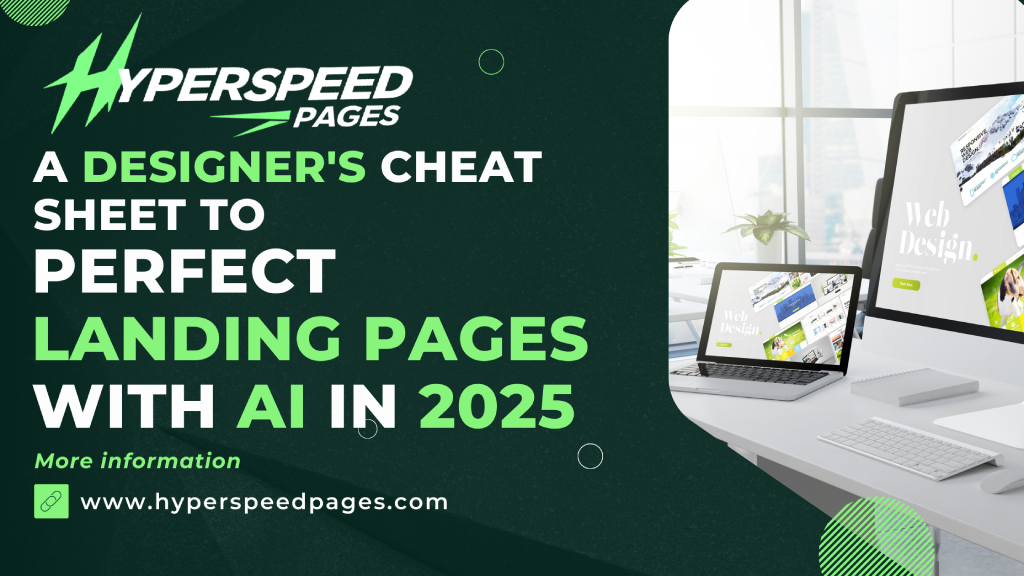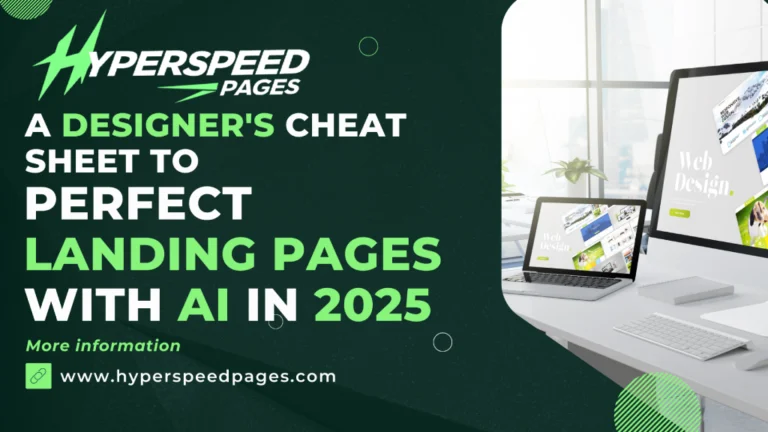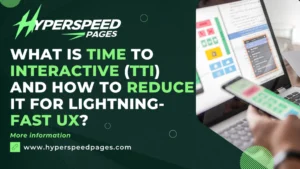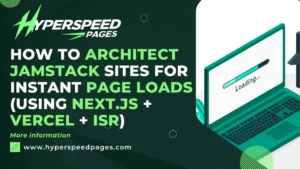
A well-crafted landing page can be the difference between a fleeting visitor and a loyal customer. With the advent of AI tools, creating high-converting, visually stunning, and SEO-optimized digital marketing landing pages has become faster, more efficient, and accessible to businesses of all sizes.
We’ll explore the cutting-edge AI tools available, dissect their functionalities, and, most importantly, understand how to integrate them into your design workflow to create landing pages that not only meet but exceed user expectations and business objectives.
Why AI is Revolutionizing Landing Page Design in 2025
AI tools have transformed landing page creation by:
- Automating design decisions (layouts, colors, fonts)
- Generating high-converting copy in seconds
- Personalizing user experiences in real-time
- A/B testing at scale with predictive analytics
- Enhancing accessibility & SEO effortlessly
Step-by-Step Guide to Creating a Perfect Landing Page with AI Tools
Step 1: Define Your Landing Page Goals and Audience
Clarity on your landing page’s purpose and target audience is critical. A successful landing page starts with a well-defined goal, such as:
1. Lead Generation: Collecting email addresses or contact information.
2. Sales Conversion: Driving purchases for a product or service.
3. Event Registration: Encouraging sign-ups for webinars or events.
4. App Downloads: Promoting mobile app installations.
Ask yourself:
1. Who is your target audience (e.g., eco-conscious businesses, tech-savvy millennials)?
2. What action do you want them to take?
3. What pain points or desires does your offer address?
Providing specific inputs to AI tools ensures the generated content and design resonate with your audience. For example, if you’re targeting eco-friendly businesses, input prompts like “sustainable office solutions” rather than generic terms like “office supplies” to create tailored content.
Step 2: Choose the Right AI Landing Page Builder
The market in 2025 is brimming with AI-powered landing page builders that streamline design, copywriting, and optimization. Here are some of the top tools, based on their features, ease of use, and integration capabilities:
Landingi
- Features: Drag-and-drop builder, 400+ customizable templates, AI-powered text and SEO generation, A/B testing, and analytics.
- Best For: Marketers seeking an all-in-one platform with robust integrations (e.g., Zapier, CRM systems).
- Why It Stands Out: Landingi’s AI ensures SEO-optimized content and aligns designs with brand guidelines automatically.
Divi AI (WordPress)
- Features: Integrated with WordPress, drag-and-drop interface, pre-designed templates, and AI-driven content creation.
- Best For: Businesses using WordPress for flexibility and advanced customization.
- Why It Stands Out: Divi AI offers no-code design with built-in marketing tools like A/B testing and conditional logic.
Sitekick AI
- Features: Generates copy, images, and layouts from a product description, with SEO optimization and responsive design.
- Best For: Beginners and small businesses needing quick, professional results.
- Why It Stands Out: Ultra-realistic AI-generated images and a user-friendly editor.
Hostinger AI Website Builder
- Features: AI Writer, AI Image Generator, AI Heatmap for CTA placement, and 150+ templates.
- Best For: Small businesses with tight budgets looking for affordability and simplicity.
- Why It Stands Out: Built-in analytics and third-party integrations (e.g., Google Analytics, Facebook Pixel).
Framer
- Features: AI-powered design assistant, interactive animations, and Figma integration.
- Best For: Designers familiar with tools like Figma who want advanced interactivity.
- Why It Stands Out: Excels in creating engaging, animated landing pages with minimal coding.
Pro Tip: Choose a tool based on your technical expertise, budget, and integration needs. For example, Landingi is ideal for marketers needing seamless CRM integration, while Framer suits designers prioritizing interactive elements.
Step 3: Design Your Landing Page with AI
AI tools simplify the design process by offering templates, automating layouts, and generating visuals. Here’s how to create a visually appealing landing page:
a) Select or Generate a Template
Most AI builders, like Landingi and Hostinger, offer professionally designed templates optimized for conversions. Alternatively, tools like Sitekick and MakeLanding can generate custom layouts based on your input. For example:
- Input your business name, niche, and target audience.
- Choose a template or let the AI generate one tailored to your brand’s style.
b) Optimize for Visual Hierarchy
AI tools can implement proven design frameworks like the F-Shaped pattern, which organizes content in a way that aligns with how users scan web pages (left-to-right, top-to-bottom). Key design principles include:
- Clear Headlines: Use bold, benefit-driven headlines (e.g., “Boost Your ROI with AI-Powered Marketing”).
- High-Quality Visuals: AI tools like Midjourney or Sitekick generate ultra-realistic images or illustrations that align with your brand.
- Consistent Branding: Tools like Landingi’s Composer adjust colors, fonts, and elements to match your brand automatically.
c) Incorporate Interactive Elements
Framer and Divi AI excel at adding animations, hover effects, and transitions to keep visitors engaged. For example, a subtle animation on a CTA button can increase click-through rates by drawing attention.
d) Ensure Mobile Responsiveness
All top AI builders in 2025 prioritize mobile-first design. Sitekick and Hostinger ensure layouts adapt seamlessly to any device, which is critical since over 50% of web traffic comes from mobile devices.
Pro Tip: Use AI Heatmaps (available in Hostinger) to analyze where visitors focus and strategically place CTAs for maximum impact.
Step 4: Craft Compelling Copy with AI
AI-powered copywriting tools generate persuasive, conversion-focused content in seconds. Here’s how to leverage them effectively:
a) Use AI Copy Generators
Tools like Copysmith, Landingi, and HubSpot’s Campaign Assistant create headlines, subheadings, and body copy tailored to your audience. For example:
- Input keywords like “sustainable products, eco-friendly, business solutions.
- Specify a tone (e.g., professional, friendly, urgent).
- Generate multiple variations and select the most compelling.
b) Focus on a Single CTA
A landing page should have one clear CTA, such as “Sign Up Now” or “Get Your Free Trial.” AI tools like Leadpages generate dozens of headlines and CTA variations to test for effectiveness.
c) Personalize Content
AI can personalize content based on visitor data, such as location or browsing behavior. For instance, Divi AI’s conditional logic displays tailored content to different user segments, improving engagement.
d) Optimize for SEO
AI tools like Landingi and Hostinger generate meta titles, descriptions, and keyword-rich content to boost search engine rankings. Ensure your copy includes:
- Primary Keywords: “AI landing page builder,” “create landing page 2025.”
- Secondary Keywords: “high-converting landing page,” “AI tools for designers.”
- Long-Tail Keywords: “how to create a landing page with AI in 2025.”
Pro Tip: Always review AI-generated copy for factual accuracy and brand alignment. Refine it to resonate with your audience’s pain points and desires.
Step 5: Enhance with AI-Powered SEO and Analytics
SEO and analytics are crucial for driving traffic and optimizing performance. AI tools streamline these processes:
a) SEO Optimization
- Landingi’s AI SEO Assistant: Generates meta tags, headers, and keyword-rich content to improve organic rankings.
- Hostinger’s AI SEO Tools: Optimize for search engines with automated keyword suggestions and content structuring.
- Unicorn Platform: Preloads pages with SEO tools to ensure high Google visibility.
b) Analytics and A/B Testing
- Built-In Analytics: Tools like Landingi and Hostinger track visitor behavior, conversions, and micro-interactions.
- A/B Testing: Divi and Instapage allow you to test multiple page variations to identify the best-performing design or copy.
- Data-Driven Insights: AI provides actionable insights, such as which CTAs drive the most clicks or where users drop off.
Pro Tip: Use AI-driven heatmaps to visualize user interactions and adjust elements like CTA placement or image positioning for better conversions.
Step 6: Integrate with Marketing Tools
AI amazon landing page builder builders integrate seamlessly with marketing platforms to streamline campaigns:
- CRM Integration: Landingi supports over 170 integrations, including Zapier, HubSpot, and Salesforce, for efficient lead management.
- Email Marketing: Tools like GetResponse and Hostinger allow you to create email capture forms and launch personalized campaigns.
- Social Media: Integrate with Facebook Pixel, Google Analytics, and TikTok Pixel for comprehensive campaign tracking.
Step 7: Test, Publish, and Optimize
Before publishing, test your landing page for:
- Loading Speed: Use tools like Google PageSpeed Insights to ensure fast load times.
- Cross-Device Compatibility: Preview on mobile, tablet, and desktop.
- CTA Clarity: Ensure the CTA is prominent and action-oriented.
Once published, monitor performance using built-in analytics and refine elements based on data. For example, if A/B testing shows a red CTA button outperforms a blue one, update the design accordingly.
Advanced Tips for High-Converting Landing Pages in 2025
- Leverage Dynamic Content: Use AI to display personalized content based on user behavior, such as showing different offers to new vs. returning visitors.
- Incorporate Urgency: Add countdown timers or limited-time offers to motivate immediate action.
- Use Multilingual Features: Tools like Landingi and Unicorn Platform offer automated translation to reach global audiences.
- Optimize for Voice Search: Include conversational long-tail keywords (e.g., “best AI landing page builder for small businesses in 2025”) to capture voice search traffic.
- Enhance Accessibility: Use AI text-to-speech tools to make your landing page inclusive for all users.
Common Pitfalls to Avoid
Generic AI Output: Always refine AI-generated content to avoid sounding robotic or off-brand.
Overloading the Page: Keep the design clean and focused on one CTA to avoid overwhelming visitors.
Neglecting Mobile Optimization: Test responsiveness thoroughly, as mobile users dominate web traffic.
Ignoring Analytics: Regularly review performance data to identify and fix underperforming elements.
AI isn’t just an assistant, it’s a co-designer. With these tools, you can:
- Save 70% of design time
- Increase conversions by 2-3X
- Stay ahead of competitors
Ready to build your AI-powered landing page? Start experimenting with these tools today!




